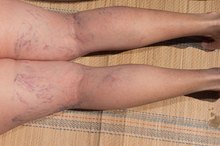DVT Symptoms in the Legs
Deep venous thrombosis, or a blood clot, can occur anywhere in the large veins of the leg. A DVT is a dangerous condition, because the clot may break free from the vein and travel to the lungs or heart. Risk factors for leg DVT include recent surgery or prolonged bed rest, a family or personal history of blood clots, pregnancy and smoking. Robert Wood Johnson University Hospital reports that a DVT in the leg can occur without any symptoms, although some common symptoms may present 1.
If you are experiencing serious medical symptoms, seek emergency treatment immediately.
Swelling
Swelling of the leg can occur around the area of a blood clot. Deep vein clots can cause fluid buildup in the tissues, which can cause a large area of the leg to swell. Lower leg clots, such as those in the calf, may cause swelling to the ankle and foot. Swelling may cause leg tissue to feel firm to the touch. DVT-related swelling may not get better with rest or by elevating the affected leg.
- Swelling of the leg can occur around the area of a blood clot.
- Deep vein clots can cause fluid buildup in the tissues, which can cause a large area of the leg to swell.
Leg Pain
Symptoms of a Blood Clot in Groin Area
Learn More
DVT can cause pain around the site of the blood clot. Discomfort may present as a stabbing or shooting pain or a persistent throbbing sensation. Discomfort is generally located over the clot, can be pinpointed to one certain area and does not radiate to other parts of the leg. The National Institutes of Health note that pain may get worse with walking or standing 2. Simply stretching the leg muscles may elicit pain, as well.
- DVT can cause pain around the site of the blood clot.
- The National Institutes of Health note that pain may get worse with walking or standing 2.
Skin Changes
Changes may occur to the skin and appearance of the leg affected by a DVT. Surface veins may appear more noticeable in the affected leg. A DVT can cause pressure buildup inside a vein, resulting in darker, more visible veins. Skin may feel warm or hot to the touch over the affected area and may accompany swelling and pain at the site. Dimpling, or small indents in the surface of the skin, may also occur in the affected leg around the area of the DVT. Skin may also appear red or flushed. Reddened skin can appear in patches around the clot site, while the rest of the leg remains normal in color and appearance, or redness may affect the entire leg, depending on the location and depth of the clot.
- Changes may occur to the skin and appearance of the leg affected by a DVT.
- Reddened skin can appear in patches around the clot site, while the rest of the leg remains normal in color and appearance, or redness may affect the entire leg, depending on the location and depth of the clot.
Related Articles
References
- Robert Wood Johnson University Hospital: DVT
- National Institutes of Health: DVT
- American Society of Hematology. Blood Clots.
- Litvinov RI, Weisel JW. What Is the Biological and Clinical Relevance of Fibrin?. Semin Thromb Hemost. 2016;42(4):333-43. doi:10.1055/s-0036-1571342
- American Heart Association. Understand Your Risk for Excessive Blood Clotting.
- Adivitiya, Khasa YP. The evolution of recombinant thrombolytics: Current status and future directions. Bioengineered. 2017;8(4):331-358. doi:10.1080/21655979.2016.1229718
- Fields JM, Davis J, Girson L, et al. Transthoracic Echocardiography For Diagnosing Pulmonary Embolism: A Systematic Review And Meta-Analysis. J Am Soc Echocardiogr 2017; 30:714. doi:10.1016/j.echo.2017.03.004
- Gibson NS, Schellong SM, Kheir DY, et al. Safety And Sensitivity Of Two Ultrasound Strategies In Patients With Clinically Suspected Deep Venous Thrombosis: A Prospective Management Study. J Thromb Haemost 2009; 7:2035. doi:10.1111/j.1538-7836.2009.03635.x
- National Blood Clot Alliance. Signs and Symptoms of Blood Clots.
- Weitz JI, Fredenburgh JC, Eikelboom JW. A Test In Context: D-Dimer. J Am Coll Cardiol 2017; 70:2411. doi:10.1016/j.jacc.2017.09.024
Writer Bio
Elizabeth Otto has been writing professionally since 2003. She is a licensed emergency medical technician-intermediate with over 10 years of experience in the field. She has worked as a clinical assistant in family health and emergency medicine since 1995. Otto is a freelance writer for various websites and holds an Associate of Science in medical assisting from Commonwealth College.







